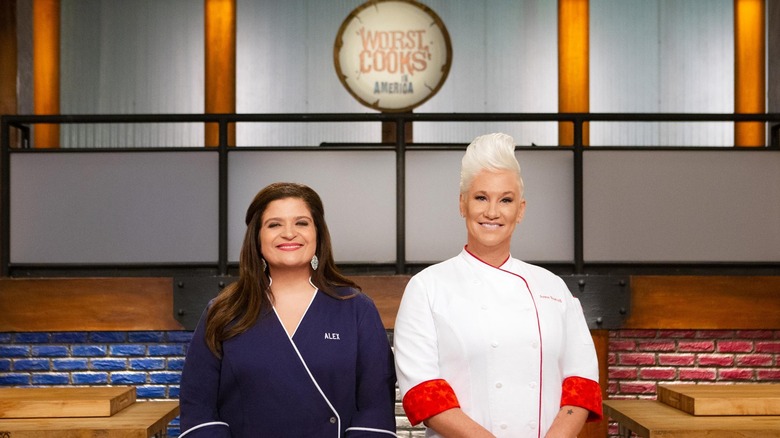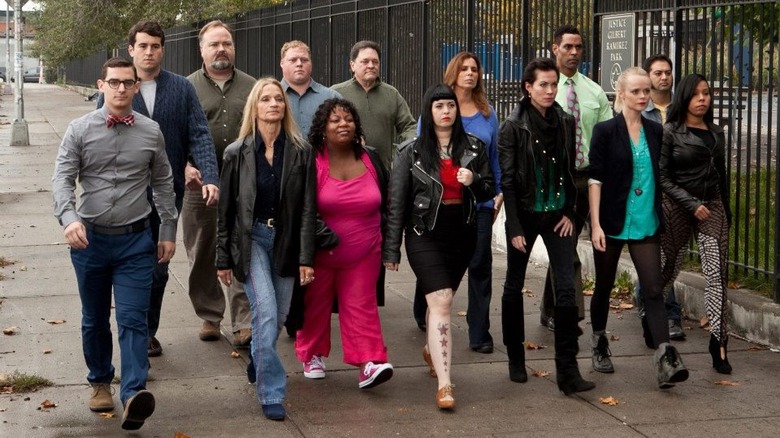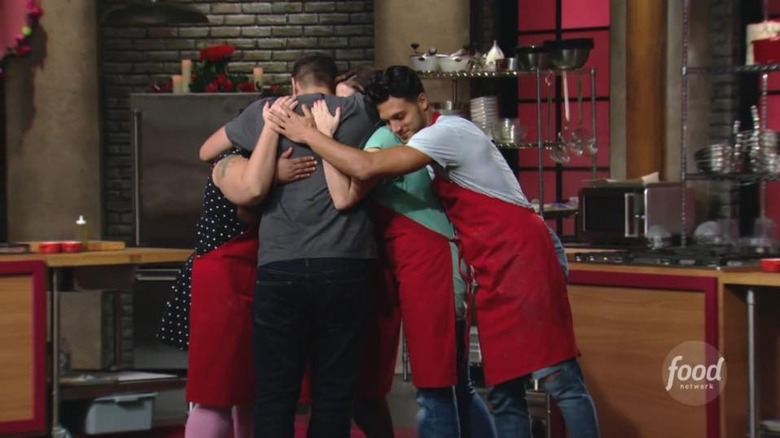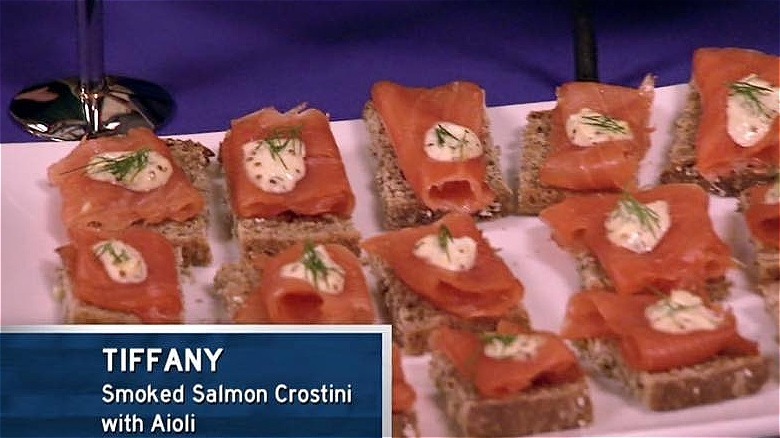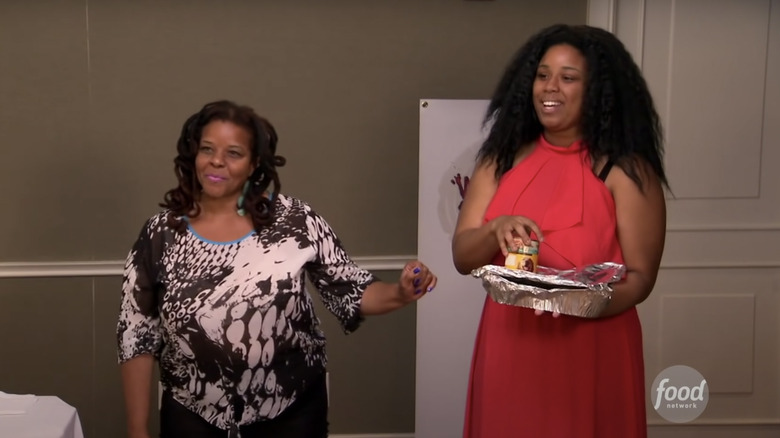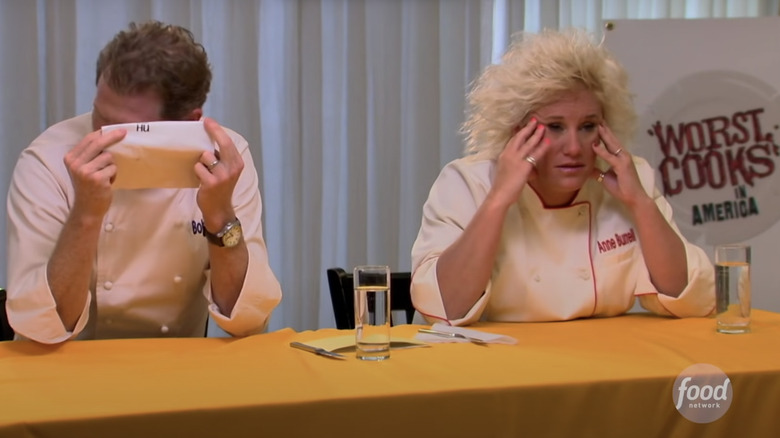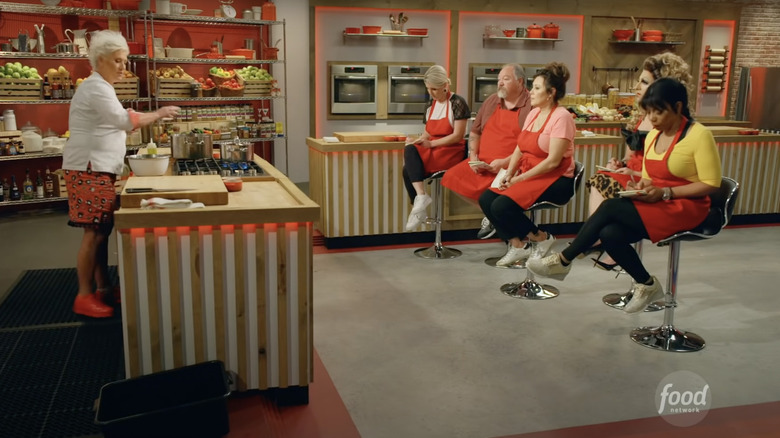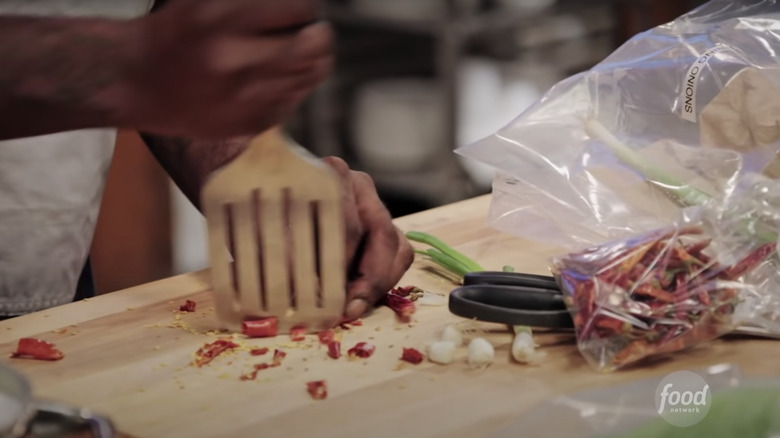What The Cameras Don't Show You On Worst Cooks In America
A decade later, "Worst Cooks in America" remains one of Food Network's most shocking spectacles. Hosted by Anne Burrell along with a bevy of big-name chefs (including Bobby Flay, Alex Guarnaschelli, and Alton Brown), the show seeks to train amateur home cooks toward culinary competence as they undergo challenges targeting food prep and kitchen etiquette. At the end of the competition, the winner takes home a $25,000 cash prize. Since premiering in 2010, the show has spanned 23 seasons with two more seasons on the way as of 2021 (via The Wrap).
From knife juggling to bizarre food pairings, the kitchen mishaps certainly make this show a hoot to watch. But the hijinks captured on screen are only the tip of the iceberg to what happens off-screen. Competing on "Worst Cooks in America" is stressful for a lot of reasons. When they're not flailing in front of the stove, recruits must abide by a number of strict rules in order to participate, including signing non-disclosure agreements that bar them from discussing their experience.
Thankfully, enough time has passed and many former contestants are spilling the beans on what transpired behind the scenes. Between long hours on set, the screening process, and interactions with the hosts, there are plenty of juicy tidbits obscured by the camera's eye. Tune in to see what the cameras don't show you on "Worst Cooks in America."
Recruits are isolated from family and friends during filming
It's never easy being away from family and friends as any contestant on "Worst Cooks in America" knows. But traveling to New York to show off their lacking chops isn't where the distance ends. To keep the competition under wraps, recruits are completely isolated from the start of the filming process to its conclusion. Former recruits have confirmed that participants hole up for weeks at a time without any of the daily distractions we normally take for granted.
"All the contestants were sequestered in a house in Brooklyn," Michael Haydin from Season 4 told The News-Times in 2013. He elaborated, "We weren't allowed any contact with the outside world — no cellphones, no internet, no TV, and definitely no cookbooks." Similarly, Buffy Mykkanen from Season 10 reported that cell phones were off-limits during production, per The Oregonian.
From the show's perspective, cutting off all communication makes sense. Reality television thrives on twists and turns to keep viewers on their toes. It would be way too easy to reveal future challenges if contestants could post on social media at a moment's notice. Additionally, the isolation amps up the emotional stakes. For example, finalists get surprise visits from loved ones to witness the transformation they've undergone first-hand, a tear-jerker moment that could only be driven by the weeks spent apart.
Long days of filming aren't caught on camera
From shattered Pyrex to scorched steaks, episodes of "Worst Cooks in America" are packed with culinary chaos. But the hour that airs on TV doesn't capture the total amount of time spent filming it. As Anne Burrell revealed to TV Insider, individual episodes take two full days to shoot, which means contestants endure long hours in the studio. Participants don't simply finish a challenge and go straight back to their hotel rooms. The production team needs to get the perfect shots of judges grimacing and stomach-turning close-ups of what is supposed to be grilled chicken. As such, the cameras continue to roll in the hopes of catching these moments — even if it takes all night.
Of course, just because the show is entertaining, it doesn't mean that it isn't grueling for the people involved. "You're standing for 18, 19 hours. It's bad," says Ann Odogwu, Season 10 finalist (via Broadway World Houston). Anna Altomari from Season 2 echoed similar sentiments to the Orange County Register, disclosing that the average shoot time could run anywhere between 7 a.m. and 10 p.m.
On the flip side, the magic of editing can whittle down a lengthy challenge into a blip across the screen. An alleged contestant wrote on Reddit that the demonstration portion, which takes about 45 minutes in real life, is condensed into a brief moment on camera. "Once they edit it, that demo is cut to like a minute, tops."
Challenges on Worst Cooks in America aren't what they appear
The cooking challenges entail much more than meets the eye — or plate. Recruits might be given a basic task to complete like making grilled cheese sandwiches or pizza dough. On the surface, it seems simple — doable even. However, the final product viewers see on screen fails to reflect exactly how much work went into it. Recruits typically have to prepare multiple items in order to meet the challenge's requirements, according to former contestant Kelli Kirkland. "It's completely unreasonable, and they know that makes for great television!" says Kirkland, who won the show's 3rd season. "For everything you see on TV, there were at least 2, and easily 3 additional things we had to do in that amount of time" (via Oakland County Moms).
Kirkland describes a challenge that seemed to only involve making three meatballs in one hour. But what the cameras left out was the side salad and homemade dressing that needed to be served too. Sure, searing a few meatballs in a pan probably doesn't take much time to prepare. But for people who've barely touched raw meat, on top of assembling whatever extra garnishes are specified in the fine print, having to cook a full-course meal can propel any cool head past the boiling point. The clock is always ticking for recruits and the camera crew overseeing each move (or mistake), but only the juiciest moments make the final taping.
Competitors can be nominated for the show by their friends or family
Applying for "Worst Cooks in America" takes a lot of guts. Being grilled by the best chefs in the business isn't for the faint of heart, even if you sign up willingly. However, not everyone who makes it to the final stage got there by choice; competitors can actually be nominated by another person. The application page allows friends, family, co-workers, and romantic partners to pitch the worst cook they know to the series for a chance to compete. There are no limitations, and pretty much anyone who has witnessed the candidate's dire culinary competence first-hand can submit an application (via Worst Cooks in America).
Many former participants have opened up about improving their skills in the kitchen, whether that's preparing a full meal or chopping an onion without heading to the emergency room. Those who have been nominated either knew about it or were unaware of how severe the situation was for the people in their lives. "I got nominated by my fiancée," Season 8 winner Nick Slater shared with Hidden Remote. "I can't cook, and someone found out there was a show for people like me." Meanwhile, Kayla Longstreth from Season 17 received a phone call alerting her of the nomination before finding out it was her own mother who submitted her application. As she told The Longmont Leader, "It felt like a total joke."
The screening process is rigorous
Just thinking about a culinary boot camp is enough to make anybody's stomach drop. A similar scenario happens on the show, only it occurs behind the scenes and out of the camera's reach. By the time contestants step foot inside Food Network's studio in NYC, they've already completed an extensive screening process. Aspiring recruits must fill out a questionnaire regarding their background and attend a follow-up interview with producers if they receive a response (per Worst Cooks in America). Cooking demos are also procedural, as the Lodi-News Sentinel reports Terry Yu had to do when he was approached to appear on Season 15. For the folks at Food Network, the standards for finding the worst of the worst are extremely high.
Applicants are not the only ones who are put on the hot seat. Anna Altamori claims friends and family members are also questioned about the candidate's abilities. "They interviewed my mom with my nominator," Altamori told the Orange County Register. "They ask if you've taken a cooking class. [...] They really screen people out." Show-runners want to make sure potential cast members are truthful about their cluelessness towards cooking, to the point that they'll ask for proof or speak with the people who know the applicants best to corroborate the facts. Producers can see right through anyone pretending to be incompetent for the chance of viral fame, and weeding out dishonest candidates keeps the show as authentic as possible.
Cooking techniques shown on camera are real
Anne Burrell's penchant for colorful socks and cutting criticism might steal the show, but at the end of the day, she's also a professionally-trained sous chef. There's a lot to exaggerate on a TV show about terrible cooks, but Burrell's expertise is not one of them. During the show's teaching segment, Burrell walks recruits through crucial cooking techniques every home chef should know.
Amid the fumbles of wielding a butcher knife or seasoning correctly, contestants learn useful tips they can take home once the cameras stop rolling. "Everything we teach is a building block to a more advanced skill," Burrell told TV Insider in 2018. "For example, we always start with knife cuts. We teach the recruits how to sear a chicken breast in one episode, and then have them take that skill to sear a pork chop in a future one. It's a crash course in culinary school."
Of course, a show focused on training terrible cooks will highlight that aspect on screen. However, hosts spend a surprising amount of time off-screen assisting recruits. Mike Glazer, who made it to the semi-finals in Season 14, recounted the extensive instructional sessions left out from episodes in a Reddit thread. "They spent an unusual amount of time teaching us," he said. A profile on Glazer following his ouster revealed his newfound confidence in cooking, describing Burrell as "such a great teacher" (via Food Network). Essentially, class is always in session.
None of the recruits' cooking skills are staged
The dreadful cooking on "Worst Cooks in America" has to be seen to be believed. And even believing is a big ask for us. How can you not know the difference between an oven and a stove? Or wield a spatula as a chopping device with zero awareness? These culinary offenses, in all their disastrous glories, boil down to one simple conclusion: The recruits really are lacking skills. No amount of show biz wizardry will change the fact that the contestants on camera don't know how to cook. Anne Burrell, the queen of seen-it-all, described the mayhem to Long Island Weekly as "sad and hilarious," adding that "the recruits really are that bad. We don't need to fake it." Ouch.
By nature, reality shows are all artifice. There's nothing natural about a set kitchen with lights, cameras, and microphones flanked at all angles and hosts watching your every move. By that assumption, neither would the cluelessness radiating on camera. It's true that fans have grown jaded over the years to the show's increasingly outrageous theatrics, doubtful of its credibility. Yet, former contestants insist what the cameras show is as real as it gets. "People always say these things are scripted, or that anybody could pretend to be a bad cook to get on the show," Buffy Mykkanen told The Oregonian. "But none of this was scripted. We were all honest with ourselves."
